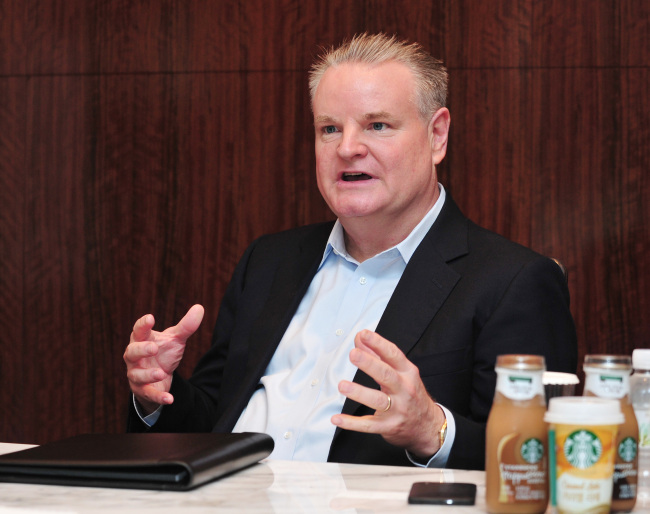Starbucks Ready-to-Drink products clearly targeted people who wanted a sip of Starbucks coffee when they are not around the outlets.
However, it has grown into an independent category, earning heaps of fans who want to enjoy quality coffee at home, work or outdoors. Though the company declined to disclose the individual sales volume in 39 countries selling Starbucks RTD, the total sales of Channel Development Business – which includes the RTD portfolio-- amount to $1.5 billion and keeps growing.
“Despite the fact that there are so many retail cafes ― more than 800 Starbucks outlets in South Korea ― today, consumers still drink the most coffee at home. So even though around 20 percent of coffee is consumed at cafes, it still means 80 percent of coffee drinking takes place elsewhere. And that is where we are building up our business,” said David Hanson, vice president and Asia region lead of global channel development at Starbucks Coffee Company.
However, it has grown into an independent category, earning heaps of fans who want to enjoy quality coffee at home, work or outdoors. Though the company declined to disclose the individual sales volume in 39 countries selling Starbucks RTD, the total sales of Channel Development Business – which includes the RTD portfolio-- amount to $1.5 billion and keeps growing.
“Despite the fact that there are so many retail cafes ― more than 800 Starbucks outlets in South Korea ― today, consumers still drink the most coffee at home. So even though around 20 percent of coffee is consumed at cafes, it still means 80 percent of coffee drinking takes place elsewhere. And that is where we are building up our business,” said David Hanson, vice president and Asia region lead of global channel development at Starbucks Coffee Company.

And among them, South Korea is an interesting market for the company, Hanson said.
Since its launch in 2005, some six years after the successful operation of Starbucks Korea, Starbucks RTD has released 15 kinds of coffees here partnering with local player Dong Suh Foods. The locally-manufactured products range from the signature Frappuccino to the Doubleshot canned coffees and Starbucks Discoveries chilled cup coffee.
Such drinks come in plastic cups, aluminum bottles or cans and are sold at large discount stores, department stores and even local convenience stores.
“Koreans are definitely the most exciting and very demanding and want to engage with the brand,” Hanson, who had spent more than six years in Korea and overlooked the country operations for more than 15 years, said.
He noted that Koreans are more health-conscious. “They prefer less sweetness in their coffee,” he said.
The company developed the espresso double-shot canned coffee exclusively for the Korean market. The little bit of bitterness after the sweetness is the kick, Hanson said. Another exclusivity for the health-enthusiasts who still cannot compromise their love for the sweet coffee is the newly-launched Skinny Mocha Frappuccino, which has reduced the fat and sweet ingredients by one-third.
Also for non-coffee drinkers, Green Tea Latte has hit the store shelves since July. “The sales are going great,” he said.
Hanson admitted that the No.1 asset for the thriving RTD business is the Starbucks brand itself.
“We call Starbucks the third place for customers, following their homes and workplaces. At Starbucks one can have a relationship with the barista, learn about coffee, look and feel, and enjoy free Wi-Fi with friends, really take a moment and have a human connection with others,” he attributed to the success of Starbucks retail outlets.
“People still want to have the same experience even when there is no Starbucks outlet around ― when they are traveling, on the golf courses, cinema or wherever you want to do,” he said.
But what if the green logo of the Siren is removed from the container? What if the brand image of Starbucks is removed, would people still want to have the Starbucks RTD?
Hanson said yes. “We hold blind tests on a regular basis and our consumers continue to appreciate the quality. They are 100 percent Arabica beans with great-brewed and great-roasted coffee. So yes, you can tell the difference,” he said.
By Bae Ji-sook (baejisook@heraldcorp.com)
-
Articles by Korea Herald









![[Weekender] Korean psyche untangled: Musok](http://res.heraldm.com/phpwas/restmb_idxmake.php?idx=644&simg=/content/image/2024/05/02/20240502050841_0.jpg&u=)








![[Eye Interview] 'If you live to 100, you might as well be happy,' says 88-year-old bestselling essayist](http://res.heraldm.com/phpwas/restmb_idxmake.php?idx=652&simg=/content/image/2024/05/03/20240503050674_0.jpg&u=)
